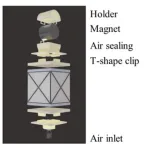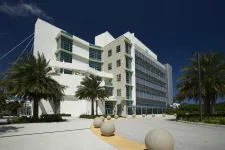Genetic variant identified that shaped the human skull base
2024-04-17
(Press-News.org)
Researchers from Tokyo Medical and Dental University (TMDU) and the Universities of Helsinki and Barcelona have identified a single nucleotide change key in the evolution of human skull morphology, affecting TBX1 gene expression and skull base development
Tokyo, Japan – Humans, Homo sapiens, have unique features compared with other closely related hominin species and primates, including the shape of the base of the skull. The evolutionary changes underlying these features were significant in allowing the evolution of our increased brain size. Now, in a study recently published in the American Journal of Human Genetics, a team from Tokyo Medical and Dental University (TMDU), the University of Helsinki, and the University of Barcelona has analyzed a genomic variant responsible for this unique human skull base morphology.
Most of the genomic changes that occurred during human evolution did not occur directly to genes themselves, but in regions responsible for controlling and regulating the expression of genes. Variants in these same regions are often involved in genetic conditions, causing aberrant gene expression throughout development. Identifying and characterizing such genomic changes is therefore crucial for understanding human development and disease.
The development of the basicranial region, the base of the skull where it joins the bones of the neck, was key in the evolution of Homo sapiens, as we developed a highly flexed skull base that allowed our increased brain size. Therefore, variants that affect the development of this region are likely to have been highly significant in our evolution.
First, the team searched for variants in just a single letter of the DNA code, called single nucleotide polymorphisms (SNPs), that caused different regulation of genes in the basicranial region in Homo sapiens compared with other extinct hominins. One of these SNPs stood out, located in a gene called TBX1.
They then used cell lines to show that the SNP, called “rs41298798”, is located in a region that regulates the expression levels of the TBX1 gene, and that the “ancestral” form of the SNP, found in extinct hominins, is associated with lower TBX1 expression, while the form found in Homo sapiens gives us higher levels of TBX1.
“We then employed a mouse model with lower TBX1 expression,” explains lead author Noriko Funato, “which resulted in distinct alterations to the morphology at the base of the skull and premature hardening of a cartilage joint where the bones fuse together, restricting the growth ability of the skull.” The changes in the Tbx1-knockout mice were reminiscent of the known basicranial morphology of Neanderthals.
These morphological changes are also reflected in human genetic conditions associated with lower TBX1 gene dosage, such as DiGeorge syndrome and velocardiofacial syndrome, further indicating the significance of this genetic variant in the evolution of our unique skull base morphology.
The identification of this genomic variant sheds light on human evolution, as well as providing insight into common genetic conditions associated with lower expression of the TBX1 gene, paving the way for greater understanding and management of these conditions.
###
The article, “A regulatory variant impacting TBX1 expression contributes to basicranial morphology in Homo sapiens”, was published in the American Journal of Human Genetics (DOI: 10.1016/j.ajhg.2024.03.012).
END
[Attachments] See images for this press release:


ELSE PRESS RELEASES FROM THIS DATE:
2024-04-17
In patients undergoing colonoscopy to screen for colorectal cancer, deeper sedation using the anesthetic drug propofol may improve detection of "serrated" polyps — a type of precancerous lesion that can be difficult to detect, reports a study in the Online First edition of Anesthesiology, the peer-reviewed journal of the American Society of Anesthesiologists (ASA).
"Our study provides the first evidence that monitored anesthesia care with propofol might increase detection of serrated polyps, which are more likely to be missed than adenomatous polyps during colonoscopy," said lead author ...
2024-04-17
The electromyographic(EMG) signal is the bioelectrical current generated during muscle contraction. It can be transmitted as an input signal to an intelligent bionic prosthetic hand to control hand movements. By increasing the number of signal acquisition channels, richer information about the intention of the action can be captured, thus improving the success rate of the recognition of the intention of the action. However, it is not better to have more acquisition channels. As the number of channels increases, the hardware system becomes more complex, and the effect of improving the accuracy of gesture recognition gradually ...
2024-04-17
The ability of the human wrist to rotate around the forearm axis in 2 directions is crucial for many daily activities. This rotation, limited to a range of approximately [-90°, 90°], restricts the wrist's capacity to execute complex operational tasks. For example, when we open or lock a door with a key, our wrist performs a large rotational movement. When we screw, the wrist needs to twist 180° several times. However, due to the limited rotation angle, the hand needs to leave the key or screwdriver several times to complete the entire work process. In order to realize large rotation ratio in a single actuator, a research team from Zhejiang ...
2024-04-17
A research team at DZNE has been awarded around one million US dollars for the development of an innovative, AI-based method to measure the “choroid plexus” three-dimensionally in human brain scans. These finely branched brain structures are the main sources of the “cerebrospinal fluid” and thus of great significance for the function of the brain and spinal cord. It is also assumed that they play a role in various neurological diseases, including Alzheimer’s. The research project is funded by the US National Institutes of Health (NIH).
The “cerebrospinal fluid” (CSF) is ...
2024-04-17
This report presents gained knowledge identified at two events during the Greenland Science Week on the 7th of November 2023 in Nuuk, Greenland:
The 1st Biennial Greenland Marine Research Seminar and
The workshop on Status and Development for East Greenland Waters
Both events had a forward-looking focus, to gain insight and knowledge from stakeholders and other parties, to be implemented in future research. The marine research seminar also served as a follow-up on earlier ECOTIP and Face-It stakeholder involvement in Greenland and was an opportunity to share project results and recommendations ...
2024-04-17
Highlights:
In lab experiments, copper shows antimicrobial properties, including against pathogens like Salmonella.
Copper beads in animal feeds may improve gut health in pigs.
A new bead design effectively delivers copper to the lower intestine.
New findings show copper beads influence the microbial makeup in a pig’s gut, but more work is needed to optimize the benefits.
Washington, D.C. — April 17, 2024 — Copper is a natural antimicrobial material that, when added to pig feed, may promote the growth and ...
2024-04-17
Florida Atlantic University’s College of Engineering and Computer Science is among eight university teams in the United States selected to work with NASA and the U.S. military to foster innovation and expertise in the small satellite sector.
NASA’s CubeSat Launch Initiative (CSLI) is partnering with the U.S. Air Force and U.S. Space Force for the 2024 Mission Concept Program. A CubeSat is among a class of research spacecraft called nanosatellites about the size of a 4-inch cube and typically weighing less than 5 pounds.
Running from May through August, the University Nanosatellite ...
2024-04-17
Waltham — April 10, 2024 — The nursing work environment, nurse education, and staffing levels are independent factors affecting hospital scores on a key measure of patient-centered care – with significant implications for reimbursements, reports a study in Medical Care. The journal is published in the Lippincott portfolio by Wolters Kluwer.
"Our results provide evidence-based guidance about which modifiable aspects of hospital nursing are likely to improve patient experience ratings," said Kathleen E. Fitzpatrick Rosenbaum, PhD, RN, CCRN, of Yale University.
How do nursing factors affect HCAHPS ...
2024-04-17
Researchers at Weill Cornell Medicine have developed a powerful, new technique to generate “movies” of changing protein structures and speeds of up to 50 frames per second.
Senior author, Dr. Simon Scheuring, the Distinguished Professor of Anesthesiology Research at Weill Cornell Medicine and colleagues developed the new approach to gain a better understanding of how biological molecules change structurally over time. Although investigators in this field routinely image static proteins and other molecules finely ...
2024-04-17
Chattering squirrels, charming coypus, and tail-slapping beavers — along with some other rodents — have orange-brown front teeth. Researchers have published high-resolution images of rodent incisors in ACS Nano, providing an atomic-level view of the teeth’s ingenious enamel and its coating. They discovered tiny pockets of iron-rich materials in the enamel that form a protective shield for the teeth but, importantly, don’t contribute to the orange-brown hue — new insights that could improve human dentistry.
Human and animal teeth are coated in a ...
LAST 30 PRESS RELEASES:
[Press-News.org] Genetic variant identified that shaped the human skull base




